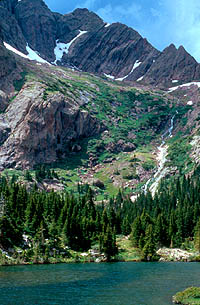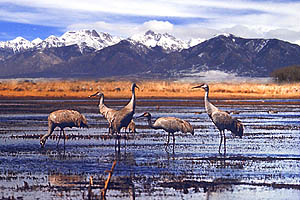 |
| NPS Photo | | Backpackers visit with a ranger at Music Pass, Great Sand Dunes National Preserve |
 |
Backpacking
The Wilderness Act of 1964 defines wilderness as "untrammeled by man, where man himself is a visitor who does not remain." Over 33,000 acres of Great Sand Dunes National Park and most of Great Sand Dunes National Preserve is legislated wilderness. Here you can hike with the assurance that this striking landscape will remain wild for countless future generations to enjoy--and share in the responsibility for protecting it and yourselves.
Free backcountry permits are required for all overnight backpacking trips. Inquire at the Visitor Center. Please note that permits must be obtained in person during Visitor Center hours: 9 a.m. to 6 p.m. summer; 9 a.m. to 4:30 p.m. fall, spring and winter. Plan to use Leave No Trace guidelines: Pack out everything you bring with you, including your trash and toilet paper. Build no fires; camp stoves are good. Do not trench around your tent. Do not damage vegetation or feed or harass wild animals. You are sharing their habitat. Camp at least 200 feet from any source of water and at least 100 feet from the trail. Stay safe and healthy! Purify all water taken from natural sources. Be prepared for sudden weather changes. Let a responsible friend or family member know where you are and when you will return. Hang or otherwise secure your food and toiletries from black bears.
Designated backcountry sites in the national park are located along the Sand Ramp Trail, in the transition area between the dunefield and the mountains. Slightly more sheltered from wind and lightning than the open dunes, these sites tend to have excellent views and some shade, but some are more than 1 mile from a source of water.
Descriptions of each backpacking site:
BUCK CREEK: 0.5 miles north of Loop 2 in the campground. This site is for families with children who want a short hike into the backcountry.
ESCAPE DUNES: 1.4 miles north of Point of No Return in an open grove of ponderosa pines. The site is near small "escape dunes", that have left the main dunefield and buried and smothered trees, leaving ghostly skeletons behind (a "Ghost Forest"). The vast majority of the pines in this grove are tall, alive, and healthy.
INDIAN GROVE: 2.9 miles north of Point of No Return. Explore the area and look for several ponderosa pines with large scars where American Indians peeled their bark for food and other uses in times past. The Scarred Trees Grove is on the National Register of Historic Sites. This is the most popular backpacking site because it is close to the main dunefield and close to Medano Creek, but it is in a sheltered grove of trees. It is the only site with a solar-composting toilet.
LITTLE MEDANO: 3.9 miles from Point of No Return, or 0.7 miles from Sand Ramp TH (high-clearance 4WD parking only). This site is situated in montane woodlands below Mount Herard. Little Medano Creek provides an good water source in most years, but may be dry in drought years.
ASPEN: 5.7 miles from Point of No Return, or 2.3 miles from Sand Ramp TH (high-clearance 4WD parking only). Aspen Camp offers incredible views of the entire dunefield from a foothills aspen grove. At 9,240 feet elevation, it is the highest designated backcountry site in the park (backcountry camping is also allowed off-trail in the national preserve; see below).
COLD CREEK: 8.9 miles from Point of No Return, or 5.5 miles from from Sand Ramp TH (high-clearance 4WD parking only). A destination for the more adventurous backpacker, Cold Creek Camp lies in a rugged valley filled with ponderosa pines. Wildlife abounds in this area including elk, deer, bears, and mountain lions.
SAND CREEK: 10.5 miles from Point of No Return, or 7 miles from the Sand Ramp TH (high clearance 4WD parking only). The campsite lies in a beautiful grove of cottonwood trees on the edge of the main dunefield. This is the only backcountry site where campfires are permitted. Collect dead and down wood only, and build your fires in the grate. Be absolutely certain the fire is out before you leave the site.
Camping in the dunes is permitted anywhere in the dunefield outside of the day use area (about 1.5 mile hike minimum over dunes). Offering unmatched views of the night sky and opportunities to observe the nocturnal life on the dunes, you must be prepared for occasional windy weather and thunderstorms.
Camping in Great Sand Dunes National Preserve, the mountainous portion of the park and preserve, is available in most areas off-trail, as long as you are following national preserve regulations. The national preserve is part of the Sangre de Cristo Wilderness area, a federally designated wilderness. You will need a permit from the Visitor Center only if you are accessing the preserve through the national park's main access area. Please Leave No Trace of your visit. Trail access is limited and extra preparedness is required. Hunting is permitted in the national preserve by license and in season - use extra caution if you hike during hunting season!
Obtain information and your free backpacking permit at the Visitor Center during open hours. Permits are first-come, first-served, and are not available in advance.
| 











